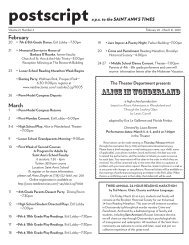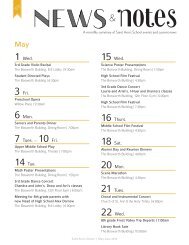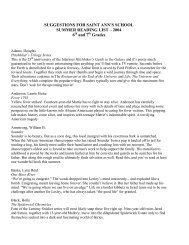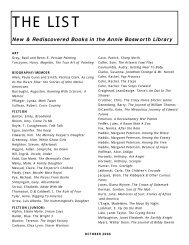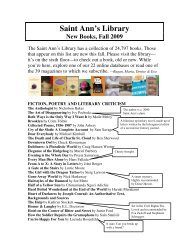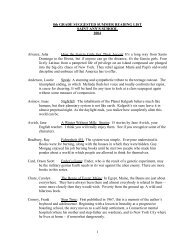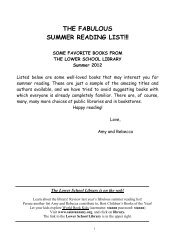Mathematical Journeys - Saint Ann's School
Mathematical Journeys - Saint Ann's School
Mathematical Journeys - Saint Ann's School
Create successful ePaper yourself
Turn your PDF publications into a flip-book with our unique Google optimized e-Paper software.
43 <br />
Luckily it is possible to find the treasure using complex numbers. We began by<br />
placing the pine and the oak at points –1 and 1, respectively. Wherever the two trees<br />
actually are does not matter as the picture can be scaled and shifted to suit any<br />
location. If we determine the locations of each stake as a function of the unknown<br />
fixed point, we find that the midpoint of line between each stake is simply –i.<br />
Therefore we know the treasure is simply found by drawing a perpendicular line<br />
through the center of the line connecting the oak and the pine and extending it 1/2 the<br />
distance between the oak and the pine. This problem demonstrates another way in<br />
which it is much simpler and straightforward to use complex numbers rather than<br />
geometry.<br />
Another interesting application of complex numbers that we explored had to<br />
do with the translation of a three-dimensional object onto a two-dimensional plane.<br />
First, we read Drawing with Complex Numbers by Michael Eastwood and Roger<br />
Penrose. We immediately learned how to represent numbers of higher dimensions as a<br />
set of real numbers, and to identify which dimension these sets belong to. A triplet of<br />
numbers belongs to our familiar three-dimensional space, whereas four numbers<br />
would belong to the fourth-dimension, five numbers to the fifth, and so on. We also<br />
learned, that it is possible in standard projection to project a lower dimensional object<br />
onto a higher dimensional plane by simply putting a 0 in the remaining slots to be<br />
filled. We talked about Gauss’ revolutionary theorem of axonometry which states that<br />
if we project a 3-D cube onto the complex plane, with one corner projected onto the<br />
origin, the sum of each of the adjacent corners’ projected points squared will be 0. We<br />
found it rather shocking to see this complex physical transformation reduced to such a<br />
simple equation, and we attempted to reconcile our intuition with the argument set<br />
forth. We also attempted a few experiments of our own, using a poster board that we<br />
had constructed for the Math Fair. We found that our experiments checked out, very<br />
nearly equalling zero. It was surprising to us that our humble attempt at trying to<br />
project a cube to a plane, armed with a laser and an imperfect graph, worked out so<br />
well.



